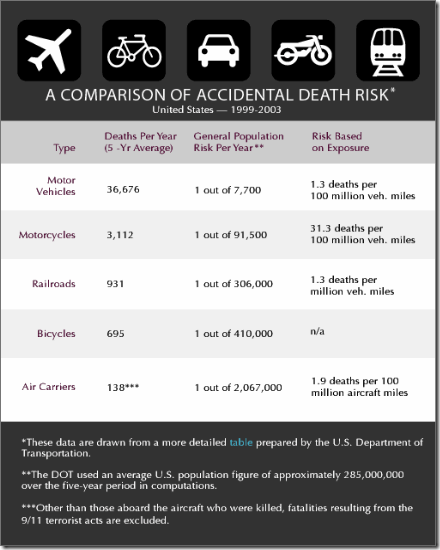- Dividing the number of people who die into the total number of people, which gives you the risk for the average person?
- Dividing the number of victims into the number of total flights all passengers took, which gives the risk per flight?
- Dividing the number of victims into the total number of miles all of them flew, which gives you the risk per mile?
Going back to Mr Ropeik’s argument, and I quote:
“These 3 options produce accurate numbers, but which one is most relevant to you depends on your personal flying patterns. Some fliers take lots of short flights and some take longer ones, for example. Since the overwhelming majority of the few plane crashes that do occur take place in connection with takeoffs and landings, the risk is less a matter of how far you fly and more a matter of how often. If you're a frequent flier, then the risk per flight means more. For occasional long-distance fliers, the risk per mile means more. A frequent, long-distance flier would want to consider both.
Here's another number problem with the risk of flying: do you calculate the risk on the basis of one year, or an average of five years, or 10, or 20? Most years no plane crashes occur, or at least very few. So the number of victims per year goes up radically in years when there are crashes. Just look at the spikes in the number of deaths from plane crashes by year in the graph at right.
Risk perception is not just a matter of the facts”
Another "feelings factor" that informs our perception of risk is awareness. The more aware of a risk we are, the more concerned about it we are. Which explains why, when there is a plane crash in the news, flying seems scarier to many of us, even though that one crash hasn't changed the overall statistical risk much.
I haven’t figured out yet what is my exact risk factor, what I can tell is that I drove the other day to Edmonton and I found myself in the middle of a snow blizzard… Not funny, so, while I live in Canada, Air Canada will be my best and loyal friend…
If you want to read Mr Ropeik’s article, go here: http://www.pbs.org/wgbh/nova/planecrash/risky.html
If you want to read the List of accidents and incidents involving commercial aircraft, go here: http://en.wikipedia.org/wiki/List_of_accidents_and_incidents_on_commercial_aircraft
Safe flights!!!

No comments:
Post a Comment